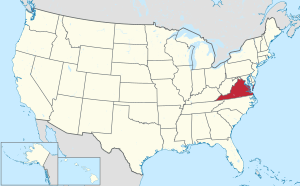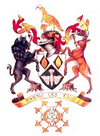Powhatan County, Virginia facts for kids
Quick facts for kids
Powhatan County
|
||
|---|---|---|

Powhatan County Courthouse
|
||
|
||

Location within the U.S. state of Virginia
|
||
 Virginia's location within the U.S. |
||
| Country | ||
| State | ||
| Founded | 1777 | |
| Named for | Powhatan | |
| Seat | Powhatan | |
| Area | ||
| • Total | 262 sq mi (680 km2) | |
| • Land | 260 sq mi (700 km2) | |
| • Water | 2.1 sq mi (5 km2) 0.8% | |
| Population
(2020)
|
||
| • Total | 30,033 | |
| • Density | 114.63/sq mi (44.26/km2) | |
| Time zone | UTC−5 (Eastern) | |
| • Summer (DST) | UTC−4 (EDT) | |
| Congressional district | 7th | |
Powhatan County is a county located in the Commonwealth of Virginia. As of the 2020 census, the population was 30,033. Its county seat is Powhatan.
Powhatan County is included in the Greater Richmond Region.
The James River forms the county's northern border, and the Appomattox River is on the south side. The county is named for the paramount chief of the powerful confederacy of tribes of Algonquian-speaking Native Americans in the Tidewater in 1607, when the British settled at Jamestown. Historically this Piedmont area had been occupied by the Siouan-speaking Monacan. They moved further west, abandoning villages in this area, under pressure from colonists.
In 1700 French Huguenot refugees settled at a Monacan abandoned village, which they renamed as Manakin Town. It was located about 20 miles above the falls on the James River. French refugees also settled on the other side of the river in two villages now known collectively as Manakin-Sabot in nearby Goochland County to the north.
Contents
History
Mowhemencho Indian Village
See Native American tribes in Virginia
Before the arrival of Europeans in the 17th century, all of the territory of Virginia, including the Piedmont area, was populated by various tribes of Native Americans. Among these in the Piedmont were the Monacan tribe, who were Siouan-speaking and were recorded as having several villages west of what the colonists called Manakin Town. They and other Siouan tribes traditionally competed with and were in conflict with the members of the Powhatan Confederacy, Algonquian-speaking tribes who generally inhabited the coastal Tidewater area. They also were subject to raids by Iroquois from the north, based in present-day New York and Pennsylvania. By the end of the 17th century, the Monacan had been decimated by warfare and infectious diseases carried by the Europeans; their survivors were absorbed into other Siouan tribes.
Manakintown
In 1700 and 1701, about 700-800 French Huguenot religious refugees on five ships arrived at Jamestown from London, having been promised by the Crown land grants and settlement in Lower Norfolk County. Many of them had been merchants and artisans in London, which was overflowing with refugees from French Catholic persecution after the Revocation in 1685. Others had found temporary refuge in Holland, Switzerland, Germany, and Ireland. As the tobacco plantations along the James River were dependent upon shipping and water transport, the area above the head of navigation at the fall line had not yet been settled.
Claiming the Norfolk area was unhealthful (although it became an area of entrepreneurs), Francis Nicholson, governor of the colony, and William Byrd, a wealthy and influential planter, offered the French refugees 10,000 acres to settle at what became known as Manakin Town, on land abandoned by the Monacan Indians about 20 miles (32 km) above the falls of the James River. They wanted a buffer from Virginia Indians for the English settlements, and Byrd hoped to develop land which he held in that area. The falls area later became the settlement of Richmond and capital of the state.
The first years on the frontier were harsh; of the 390 French who settled at Manakin Town, only 150 lived there by 1705. They were extremely isolated, short of supplies, and initially ill-suited to carve an agricultural settlement from the frontier. They were able to use some land cleared by the Monacans. Although they had planned to build a town based on the French village model, it proved impractical, as the most fertile land lay along the James River. So they placed their church and glebe lands in the center of the granted acreage and that became the center for their farms. The grant was divided more or less equally, with each grantee in 1710 receiving about 133 acres, stretching in narrow plots from the river. By then, many families had already migrated to other parts of Virginia and North Carolina. The grants would prove too limited for growing families and services of the Manakin Episcopal Church (King William Parish) were gradually held more in English than French.
The French became established and assimilated in colonial Virginia; they ultimately adopted the English language, purchased African slaves when they could afford them, and intermarried with many planter families of English descent in the area and to the west. Many of the Huguenot descendants migrated west into the Piedmont and across the Appalachian Mountains into Kentucky and Tennessee, as did other European Americans, as well as south along the coast, with some ultimately settling in Texas.
Present-day State Route 288 and State Route 711 run about a mile east of the former town, where the 1895 Huguenot Memorial Chapel and Monument, the fourth church building constructed there, is maintained by the Huguenot Society. It is listed on the National Register of Historic Places. In addition, the nearby Manakin Episcopal Church, built in 1954, continues full services for a regional congregation.
Powhatan County
In May 1777, the Virginia General Assembly created Powhatan County out of land from the eastern portion of Cumberland County between the Appomattox and James rivers. Residents named the county in honor of Chief Powhatan, paramount chief of the Powhatan Confederacy. He had allied with Algonquian-speaking tribes in the Tidewater, numbering about 30,000 in population at the time of the Jamestown settlement. He was also the father of Pocahontas, whom colonists perceived as friendly. While in captivity, she accepted Christianity and married English settler John Rolfe. Many of their descendants were counted among the First Families of Virginia.
For the first two years after the county was formed, Mosby Tavern served as the Powhatan County courthouse. When a new courthouse was built in 1778, the immediate area was named "Scottville" after General Charles Scott, a Revolutionary War soldier. He was later elected governor of the Commonwealth of Kentucky after it was formed in 1792 as a separate state from land ceded by Virginia. The courthouse area was later named Powhatan.
During the late 18th and early 19th centuries, the county became more developed with expansive plantations as the frontier moved west. Yeomen farmers moved further into the backcountry where land was more affordable. The larger planters used numerous African-American slaves to produce tobacco, and later mixed crops, including wheat. The county continued to be organized on an agricultural economy until after World War II. It still has rural areas and historic plantations, but is being developed with suburban residential housing and related retail.
Geography
According to the U.S. Census Bureau, the county has a total area of 262 square miles (680 km2), of which 260 square miles (670 km2) is land and 2.1-square-mile (5.4 km2) (0.8%) is water. It is bordered on the north by the James River and on the south by the Appomattox River.
Adjacent counties
- Goochland County - north
- Chesterfield County - east
- Amelia County - south
- Cumberland County - west
Major highways
 US 60
US 60 US 522
US 522 SR 13
SR 13 SR 288
SR 288 SR 300
SR 300
Demographics
| Historical population | |||
|---|---|---|---|
| Census | Pop. | %± | |
| 1790 | 6,822 | — | |
| 1800 | 7,769 | 13.9% | |
| 1810 | 8,073 | 3.9% | |
| 1820 | 8,292 | 2.7% | |
| 1830 | 8,517 | 2.7% | |
| 1840 | 7,924 | −7.0% | |
| 1850 | 8,178 | 3.2% | |
| 1860 | 8,392 | 2.6% | |
| 1870 | 7,667 | −8.6% | |
| 1880 | 7,817 | 2.0% | |
| 1890 | 6,791 | −13.1% | |
| 1900 | 6,824 | 0.5% | |
| 1910 | 6,099 | −10.6% | |
| 1920 | 6,552 | 7.4% | |
| 1930 | 6,143 | −6.2% | |
| 1940 | 5,671 | −7.7% | |
| 1950 | 5,556 | −2.0% | |
| 1960 | 6,747 | 21.4% | |
| 1970 | 7,696 | 14.1% | |
| 1980 | 13,062 | 69.7% | |
| 1990 | 15,328 | 17.3% | |
| 2000 | 22,377 | 46.0% | |
| 2010 | 28,046 | 25.3% | |
| 2020 | 30,033 | 7.1% | |
| U.S. Decennial Census 1790-1960 1900-1990 1990-2000 2010 2020 |
|||
2020 census
| Race / Ethnicity | Pop 2010 | Pop 2020 | % 2010 | % 2020 |
|---|---|---|---|---|
| White alone (NH) | 23,231 | 25,497 | 82.83% | 84.06% |
| Black or African American alone (NH) | 3,798 | 2,477 | 13.54% | 8.17% |
| Native American or Alaska Native alone (NH) | 75 | 59 | 0.27% | 0.19% |
| Asian alone (NH) | 131 | 167 | 0.47% | 0.55% |
| Pacific Islander alone (NH) | 10 | 18 | 0.04% | 0.06% |
| Some Other Race alone (NH) | 16 | 99 | 0.06% | 0.33% |
| Mixed Race/Multi-Racial (NH) | 283 | 1,224 | 1.01% | 4.04% |
| Hispanic or Latino (any race) | 502 | 792 | 1.79% | 2.61% |
| Total | 28,046 | 30,033 | 100.00% | 100.00% |
Note: the US Census treats Hispanic/Latino as an ethnic category. This table excludes Latinos from the racial categories and assigns them to a separate category. Hispanics/Latinos can be of any race.
Education
Powhatan County Public Schools (PCPS) serves over 4,300 students in the county. PCPS composed of three elementary schools: Pocahontas Elementary, Powhatan Elementary, and Flat Rock Elementary. These elementary schools currently educate Kindergarten through 5th grade. Powhatan Middle School was completed in 2018, and educates 6th grade through 8th grade. Powhatan High School, located at 1800 Judes Ferry Road, is the county's only secondary school that teaches 9th through 12th grade. The current superintendent of PCPS is Dr. Eric L. Jones (2021).
Notable people
- William Henry Ashley, American frontiersman, politician, and co-owner of the Rocky Mountain Fur Company
- John Singleton Mosby, born in Powhatan County, was known by his nickname, the "Gray Ghost", was a Confederate army cavalry commander of the 43rd Battalion in the American Civil War. He later served as the American consul to Hong Kong and also in the U.S. Department of Justice. He also served as a lawyer for the Southern Pacific Railroad.
- Lynne Doughtie, resident of Powhatan and US Chairwoman and CEO of the major accounting firm KPMG, was named to the "Most Powerful Woman" list of Fortune Magazine.
See also
 In Spanish: Condado de Powhatan para niños
In Spanish: Condado de Powhatan para niños



